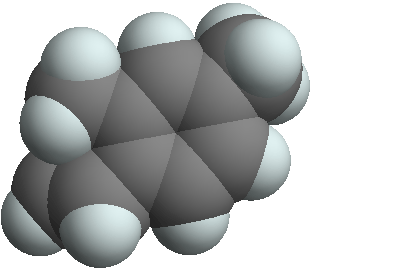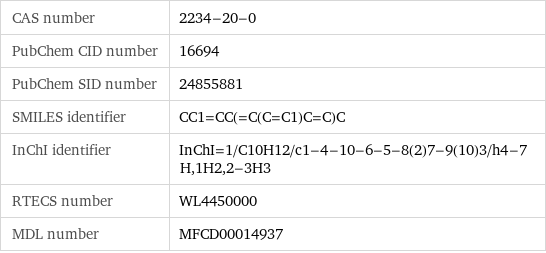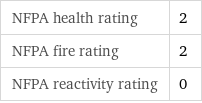Input interpretation

2, 4-dimethylstyrene
Chemical names and formulas

formula | (CH_3)_2C_6H_3CH=CH_2 Hill formula | C_10H_12 name | 2, 4-dimethylstyrene IUPAC name | 2, 4-dimethyl-1-vinylbenzene alternate names | 1, 3-dimethyl-4-vinylbenzene | 1-ethenyl-2, 4-dimethyl-benzene | 1-ethenyl-2, 4-dimethylbenzene | 1-vinyl-2, 4-dimethylbenzene | 2, 4-dimethyl-1-vinyl-benzene | 4-vinyl-m-xylene | benzene, 1-ethenyl-2, 4-dimethyl- mass fractions | C (carbon) 90.9% | H (hydrogen) 9.15%
Lewis structure

Draw the Lewis structure of 2, 4-dimethylstyrene. Start by drawing the overall structure of the molecule, ignoring potential double and triple bonds: Count the total valence electrons of the carbon (n_C, val = 4) and hydrogen (n_H, val = 1) atoms: 10 n_C, val + 12 n_H, val = 52 Calculate the number of electrons needed to completely fill the valence shells for carbon (n_C, full = 8) and hydrogen (n_H, full = 2): 10 n_C, full + 12 n_H, full = 104 Subtracting these two numbers shows that 104 - 52 = 52 bonding electrons are needed. Each bond has two electrons, so in addition to the 22 bonds already present in the diagram add 4 bonds. To minimize formal charge carbon wants 4 bonds. Identify the atoms that want additional bonds and the number of electrons remaining on each atom: Fill in the 4 bonds by pairing electrons between adjacent highlighted atoms. Note that the six atom ring is aromatic, so that the single and double bonds may be rearranged: Answer: | |
3D structure

3D structure
Basic properties

molar mass | 132.21 g/mol phase | liquid (at STP) melting point | -64 °C boiling point | 73.5 °C (measured at 1333 Pa) density | 0.906 g/cm^3 solubility in water | insoluble
Units

Liquid properties (at STP)

density | 0.906 g/cm^3 refractive index | 1.543
Units

Chemical identifiers

CAS number | 2234-20-0 PubChem CID number | 16694 PubChem SID number | 24855881 SMILES identifier | CC1=CC(=C(C=C1)C=C)C InChI identifier | InChI=1/C10H12/c1-4-10-6-5-8(2)7-9(10)3/h4-7H, 1H2, 2-3H3 RTECS number | WL4450000 MDL number | MFCD00014937
NFPA label

NFPA label

NFPA health rating | 2 NFPA fire rating | 2 NFPA reactivity rating | 0
Safety properties

flash point | 60 °C

DOT hazard class | 3 DOT numbers | 1993
Toxicity properties

RTECS classes | other